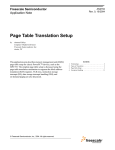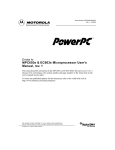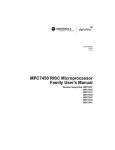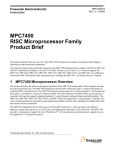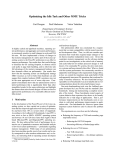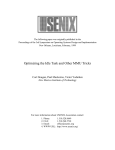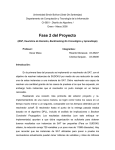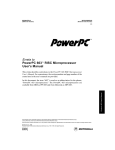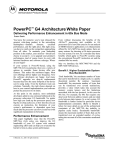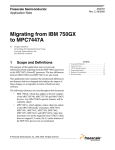Download Page Table Translation Setup
Transcript
Freescale Semiconductor Application Note Document Number: AN2794 Rev. 1, 08/2010 Page Table Translation Setup by Networking and Multimedia Group Freescale Semiconductor, Inc. Austin, TX This application note describes memory management unit (MMU) page table setup for classic Power Architecture®-based devices, such as the MPC755. The simplest page table setup is discussed using the page table translation mechanism to augment the block address translation (BAT) registers. TLB miss, instruction storage interrupt (ISI), data storage interrupt handling (DSI), and on-demand paging are also discussed. © 2010 Freescale Semiconductor, Inc. All rights reserved. 1. 2. 3. 4. 5. Contents Terminology . . . . . . . . . . . . . . . . . . . . . . . . . . . . . . . . 2 Types of Translation . . . . . . . . . . . . . . . . . . . . . . . . . . 2 Page Table Setup . . . . . . . . . . . . . . . . . . . . . . . . . . . . . 3 Exception Handling . . . . . . . . . . . . . . . . . . . . . . . . . 14 Revision History . . . . . . . . . . . . . . . . . . . . . . . . . . . . 23 Terminology 1 Terminology The following terms are used in this document: BAT Block address translation mechanism. A set of registers that contain the translation information and access privileges for blocks of memory. DINK Dynamic interactive nano kernel. This is a nano kernel and debugger for the PowerPC systems. DSI Data storage interrupt (offset 0x300). This is the exception that a Power Architecture-based processor takes when a data access cannot be translated by the MMU. ISI Instruction storage interrupt (offset 0x400). This is the exception that a Power Architecture-based processor takes when an instruction access cannot be translated by the MMU. Hash function A mathematical construct that generates indexes (hash values) into a table to minimize collisions. Hash collision A condition where two hash values index into the same table entry. MMU Memory management unit. This on-chip unit manages memory accesses on a processor. MSR Machine state register. Contains information on various states of the processor. Page 4 Kbytes of contiguous memory starting at a 4-Kbyte boundary PTE Page table entry. Contains the information on how a memory page may be translated. PTEs are stored in memory and each one is 8 bytes in size. PTEG A group of 8 PTEs. The address of a PTEG should be aligned to a 64-byte boundary. SDR1 A register that defines the high-order bits for the physical base address and the size of the page table. SRx Segment register used for page translation. SRR1 Machine status save restore register 1. This register stores information when an exception is taken. TLB Translation lookaside buffers. These on-chip storage entities store (cache) recently accessed PTEs. 2 Types of Translation Processor-generated memory accesses require address translation before they go out to the memory subsystem. Instruction and data access translations are enabled through two bits (IR and DR, respectively) in the machine state register (MSR). When translation is disabled the processor is said to be in real addressing mode. In this mode all memory is mapped one-to-one with effective memory/cache attributes (WIMG settings) of 0001 or 0011. When translation is enabled, address translation is performed either through BATs or page tables and TLBs. Figure 1 summarizes the translation types. Page Table Translation Setup, Rev. 1 2 Freescale Semiconductor Page Table Setup 0 31 Effective Address Segment Descriptor Located (T = 1) Address Translation Disabled (MSR[IR] = 0, or MSR[DR] = 0) Match with BAT Registers (T = 0) Block Address Translation Page Address Translation 0 51 Virtual Address Direct-Store Segment Translation Real Addressing Mode Effective Address = Physical Address Look Up in Page Table 0 31 0 Implementation-Dependent 31 Physical Address 0 31 0 Physical Address 31 Physical Address Figure 1. Address Translation Types For more details about the translation types, see the Programming Environments Manual for 32-Bit Implementations of the PowerPC Architecture™. 3 Page Table Setup This application note explains how to set up page tables for use as extra BATs. It does not provide detailed descriptions of registers and terms. These can be found in the Programming Environments Manual for 32-Bit Implementations of the PowerPC™ Architecture. To set up page tables the following steps are followed. Note that the MMU should be off (translation disabled through MSR[IR,ID]) when the following setup is run. At the end of the setup, the MMU is turned back on. Page Table Translation Setup, Rev. 1 Freescale Semiconductor 3 Page Table Setup 3.1 Page Table Size One page table entry (8 bytes) covers 4 Kbytes of memory. For example, to set up pages for sixteen Mbytes of memory, 4096 entries (or 32 Kbytes of page table space) are required. However, due to the likelihood of collisions in accessing the PTEs, a minimum of four times as much, or 16384 entries (or 128 Kbytes of page table space), is recommended. Table 1 lists the minimum recommended page table sizes for different memory sizes. The ‘x’ for HTABORG gets filled with the upper address bits of the page table in memory (see Section 3.2, “Configuring SDR1 Register”). Table 1. Minimum Recommended Page Table Sizes Settings for Recommended Minimum Recommended Minimum Memory Covered Number of Mapped Pages (PTEs) Number of PTEGs HTABORG (Maskable Bits 7–15) HTABMASK 213 210 x xxxx xxxx 0 0000 0000 (217) 214 211 x xxxx xxx0 0 0000 0001 32 Mbytes (225) 256 Kbytes (218) 215 212 x xxxx xx00 0 0000 0011 (226) (219) 216 213 x xxxx x000 0 0000 0111 217 214 x xxxx 0000 0 0000 1111 (221) 218 215 x xxx0 0000 0 0001 1111 4 Mbytes (222) 219 216 x xx00 0000 0 0011 1111 (223) 220 217 x x000 0000 0 0111 1111 Memory for Page Tables 8 Mbytes (223) 16 Mbytes 64 Mbytes 64 Kbytes (216) (224) 128 Kbytes 512 Kbytes 128 Mbytes (227) 256 Mbytes 1 Mbyte (220) (228) 2 Mbytes 512 Mbytes (229) 1 Gbytes (230) 8 Mbytes 2 Gbytes (231) 16 Mbytes (224) 221 218 x 0000 0000 0 1111 1111 (232) (225) 222 219 0 0000 0000 1 1111 1111 4 Gbytes 32 Mbytes Assuming the starting and ending memory addresses are in r3 and r4 registers respectively, the following code stores the page table size to r6. //calculate PT_size ((end-start)*8/4096)*4 or (end-start)/128 //minimum size of PT_size is 64 Kbytes //PT_size is * 4 (to satisfy minimum //requirement) (see table 7-22 of PEM for 32 bit manual) sub r6, r4, r3 srwi r6, r6, 7 //div by 128 to get pt_size rlwinm. r8, r6, 20, 12, 31 //is PT_size >= 64 Kbytes bne cont lis r6, 0x10 //if not set to 64 Kbytes cont: Page Table Translation Setup, Rev. 1 4 Freescale Semiconductor Page Table Setup 3.2 Configuring SDR1 Register The HTABORG field of SDR1 register (Figure 2) contains the upper 16 bits of the page table location. HTABORG and HTABMASK of SDR1 register need to be programmed according to Table 1. Reserved 0000 000 HTABORG 0 15 16 HTABMASK 22 23 31 Figure 2. SDR1 Register Format SDR1[HTABMASK] is a mask with as many low-order ones as there are low-order zeros in the HTABORG. For example, if the page table is located at 0x03A0_0000, HTABORG and HTABMASK should be programmed to 0b0000_0011_1010_0000 and 0b0000_0000_0001_1111 respectively. The relation between the HTABMASK, HTABORG and the size of the memory constrain the location of the page table. The best way to satisfy these requirements is to place the page table at the upper end of the physical memory. For example, for 64 Mbytes of memory, 512 Kbytes of memory is required for the page tables (from Table 1). Placing the table at the upper end of the memory will yield page table base address of 0x0400_0000 - 0x0008_0000 = 0x03F8_0000. An address of 0x03F8_0000 satisfies the requirement that HTABORG = 0b0000_0011_1111_1000 and HTABMASK = 0b0000_0000_0000_0111. The following PowerPC assembly code calculates the page table location and sets the SDR1. In the assembly code, r6 contains the page table size (see Section 3.1, “Page Table Size”), and memSize is a function that returns (in r3) the total memory available on a system. SDR1 is Special Purpose Register (SPR) 25. //calculate PT_location (memSize-PT_size) bl memSize sub r3, r3, r6 //PT_loc=memSize-PT_size //set up SDR1 xor r9, r9, r9 ori r9, r9, 0xffff //set HTABORG of SDR1 rlwinm r8, r9, 16, 0, 15 //r8=0xffff0000 and r15, r3, r8 //r9=0x0000ffff //set HTABMASK of SDR1 //in C it is: //for(i=0x0000ffff;(sdr1_value&(i<<16)) && i>0;i>>=1); htabmask: rlwinm r8, r9, 16, 0, 15 //i<<16 and. r8, r8, r15 //c1=sdr1_value & i<<16 Page Table Translation Setup, Rev. 1 Freescale Semiconductor 5 Page Table Setup beq exit_htabmask //if c1=0 then exit cmpli r9, 0 //i>0 ? ble exit_htabmask //if i=<0 then exit srwi r9, r9, 1 //i>>=1 b htabmask exit_htabmask: //now r9 should have the HTABMASK 3.3 or r15, r15, r9 mtspr 25, r15 //set SDR1 Configuring the Segment Registers The segment registers contain the virtual segment IDs (VSIDs) that are used for page table translation. The upper 4 bits of effective address dictate which segment register to use. If more than one segment register is being used, then each one needs to have a unique VSID. To accomplish this, the following code loads up the VSIDs with consecutive numbers. In the code, r8 and r9 contain the starting and ending address of the memory area to be covered by page tables. //set up SRx rlwinm r3, r8, 4, 28, 31 //extract 4 MSBs rlwinm r4, r9, 4, 28, 31 //extract 4 MSBs bl set_srx addi r3, r3, 1 cmpw r3, r4 ble srx_set srx_set: //expects r8=value r9=sr index Where set_srx is defined as: //set srx registers .global set_srx set_srx: cmpwi r4, 0 beq mtsr0 cmpwi r4, 1 beq mtsr1 //fill in the same sequence for SR2 up to SR14 here cmpwi r4, 15 beq mtsr15 Page Table Translation Setup, Rev. 1 6 Freescale Semiconductor Page Table Setup mtsr0: mtsr 0, r3 blr mtsr1: mtsr 1, r3 blr //fill in the same sequence for SR2 up to SR14 here mtsr15: mtsr 15, r3 blr 3.4 Clearing the Page Tables Before setting up the page tables, it is important to zero out the page table memory space first. This is because page table entries are searched by looking at the valid bit of the entries and finding an invalid entry. If the memory area is not cleared first, then false valid entries will create table collisions. To clear the page table memory area, a simple store word instruction is used. Other means can be used as well. Assuming r6 contains the table size in bytes and r7 contains the table location, the following assembly code clears the page table memory. //clear out page table memory rlwinm r6, r6, 30, 0, 31 mtctr r6 xor r8, r8, r8 subi r7, r7, 4 //divide by 4 //pre-decrement r7 zero_out_pte: 3.5 stwu r8, 4(r7) bdnz zero_out_pte Constructing the Page Table When looking for a page table entry for a page (4-Kbyte block), the processor uses a hash function, in combination with the segment registers (for the VSID field of the virtual address) and the SDR1 register, to construct a PTE group (PTEG) address (see Figure 3). In a similar fashion, when software sets up the page tables, it should use the same algorithm to construct the PTEG address for a PTE. Once the PTEG is calculated from the algorithm, then the first empty PTE (as indicated by the valid bit being cleared) is used to store the translation information. If all the PTEs in a PTEG are already used (valid), then the second hash value is generated from the first hash by inverting all the bits (one’s complement). To indicate that the PTE is placed there using the second hash, the software sets the H bit in the upper PTE. The detailed assembly code is described in subsequent sections. The process is repeated for each page of the memory area that is covered by the page table. Page Table Translation Setup, Rev. 1 Freescale Semiconductor 7 Page Table Setup 0 Virtual Page Number (VPN) 23 24 45 Virtual Segment ID (24-bit) 52-Bit Virtual Address 29 30 39 40 51 API (6-bit) Byte Offset (12-bit) Page Index (16-bit) (3 Bit) (16-bit) 000 Hash Function SDR1 0 67 15 16 xxxx xx . . . . . . 00 (16-bit) 22 23 0000000 31 0 8 9 18 Hash Value (19-bit) 00 . . . . 011. . .1 (9-bit) Mask 10 bits 9 bits Base Address AND PAGE TABLE PTE0 OR PTE7 8 bytes PTEG0 0 67 (7-bit) 15 16 (9-bit) 25 26 (10-bit) 31 000000 (6 Bit) PTEG Select PTEGn 32-Bit Physical Address of Page Table Entry 64 Bytes Lower PTE Upper PTE 01 24 25 26 VSID (24-bit) V 31 API (6-bit) 0 19 Physical (Real) Page Number (RPN) (20-bit) H 32-Bit Physical Address 23 25 000 R C 29 31 0 PP WIMG RPN (20-bit) Byte Offset (12 bit) Figure 3. Generation of Addresses for Page Tables Page Table Translation Setup, Rev. 1 8 Freescale Semiconductor Page Table Setup The following sections detail how a PTE is loaded into the table. 3.5.1 Segment Register Selection and Loop Setup PTEs are constructed for each page in the memory range covered. For each page we figure out which segment register to use. Segment register is selected by the 4 upper bits of the effective address (there are 16 segment registers). The following source code sets up the loop for each page in the address range that is to be covered and reads the appropriate segment register. //loop for each 4k block of memory load_PTEs: cmpw r3, r4 bge check_low_memory //figure out which sr we need rlwinm r8, r3, 4, 28, 31 //get_srx expects input in r8 and outputs to r13 get_srx Where get_srx is: /get srx registers .global get_srx get_srx: cmpwi r8, 0 beq mfsr0 cmpwi r8, 1 beq mfsr1 //...repeat for mfsr2 up to mfsr15 mfsr0: mfsr r13, 0 blr mfsr1: mfsr r13, 1 blr //...repeat for sr2 up to sr15 3.5.2 Setting Up Upper and Lower PTEs PTEs have the format shown at the bottom of Figure 3, with an upper word and a lower word. We set up the PTE before we search in the table to find where to put it. The following code, which assumes SRx Page Table Translation Setup, Rev. 1 Freescale Semiconductor 9 Page Table Setup content in r13, effective address in r3 and WIMG bits in r5, sets up the upper word of the PTE in r11 and the lower word of the PTE in r12. //construct V/VSID/API for loading to PTE later rlwinm r11, r13, 7, 1, 24 //extract VSID from SRx rlwimi r11, r3, 10, 26, 31 //extract API from EA //and insert in VSID/API reg oris r11, r11, 0x8000 //set Valid bit //set up lower word of the PTE with EA=PA 3.5.3 rlwinm r12, r3, 0, 0, 19 //extract RPN rlwimi r12, r5, 3, 25, 28 //insert WIMG ori r12, r12, 0x182 //R=C=1,PP=10 Generating the First Hash Value The first hash value is generated by performing an exclusive OR of the 19 low-order bits of the VSID and bits 4-19 of the effective address preceded by three 0s (see Figure 4). Page Table Translation Setup, Rev. 1 10 Freescale Semiconductor Page Table Setup Primary Hash: VA5 VA23 Low-Order 19 Bits of VSID (from Segment Register) XOR 4 000 19 Page Index (Virtual Address bits 24–39 or Effective Address bits 4–19) = Hash Value 1 Output of Hashing Function 1 0 8 9 18 Secondary Hash: 0 18 Hash Value 1 One’s Complement Function Output of Hashing Function 2 0 8 9 Hash Value 2 18 Figure 4. Hashing Functions for Page Tables The assembly code that generates the hash1 value is below. The code assumes the effective address is in r3 and the segment register contents are in r13. It stores the hash1 value into r14. //hash1 = SRx[13-31] xor ( 0b000 || EA[4-19]) 3.5.4 rlwinm r14, r3, 20, 16, 31 //extract EA[4-19] rlwinm r12, r13, 0, 13, 31 //extract SRx[13-31] xor r14, r14, r12 //xor the two Calculating the PTEG Address The PTEG address is then generated according to the algorithm shown in Figure 3. The code for this part of the algorithm is below. In this code, the SDR1 value is assumed to be contained in r15, and the hash1 value is stored in r15. At the end of this code, r9 holds the PTEG address. //calculate PTEG address //PTEG address = SDR1[0-6] || // (SDR1[7-15] | (SDR1[23-31] & hash[13-21])) // || hash[22-31] || 0b000000 Page Table Translation Setup, Rev. 1 Freescale Semiconductor 11 Page Table Setup calculate_PTEG: rlwinm r12, r14, 22, 23, 31 //hash[13-21] and r12, r12, r15 //tmp1 = SDR1[23-31] & hash[13-21] rlwinm r8, r15, 16, 23, 31 //SDR1[7-15] or r12, r12, r8 //tmp2 = SDR1[7-15] | tmp1 xor r9, r9, r9 //zero out PTEG address rlwimi r9, r15, 0, 0, 6 //insert SDR1[0-6] into PTE addr[0-6] rlwimi r9, r12, 16, 7, 15 //insert tmp2 into PTE addr[7-15] rlwimi r9, r14, 6, 16, 25 //insert hash[22-31] into //PTE addr[16-25] 3.5.5 Searching for an Empty PTE location After we have the address of the PTEG, we traverse through the eight PTEs within the PTEG to find an empty (available) PTE. An empty PTE is identified by its valid bit (bit 0 of the upper PTE) being clear. In this code, r9 holds the address of the PTEG. //search for an entry within the 8 PTEs in the PTEG subi r9, r9, 8 //pre-decrement r9 for PTE search //search and insert entry li r10, 8 mtctr r10 Page Table Translation Setup, Rev. 1 12 Freescale Semiconductor Page Table Setup next: lwzu r8, 8(r9) //load PTE rlwinm. r8, r8, 1, 31, 31 //check valid bit beq //if we find an empty PTE then exit_loop // exit loop bdnz next //otherwise continue //if we get here then we did not find an empty entry in which case we generate //2nd hash (see Section 3.5.7, “Generating the Second Hash Value”) 3.5.6 Loading the Upper and Lower Words of PTE After we have successfully located an empty PTE location, we load the PTE we constructed in Section 3.5.2, “Setting Up Upper and Lower PTEs,” to the empty table location. exit_loop: //we have found an empty PTE. Populate it for current EA stw r11, 0(r9) //load upper word of PTE stw r12, 4(r9) //load lower word of PTE 3.5.7 Generating the Second Hash Value If there is no empty PTE within the PTEG in the previous section, a second hash is calculated. The second hash is a one’s complement of the first hash (see Figure 4). The following code first checks if second hash has already been attempted (indicated by the H bit in the PTE (contained in r11) that we are trying to insert to the table). If not, then it performs the second hash; otherwise, it flags an error. The first hash is assumed to be in r14. //Check to see whether second hash already tried rlwinm. r12, r11, 26, 31, 31 //check for H bit in V/VSID/API // register bne return_error //if set, flag an error //if second hash not tried, then try second hash 3.5.8 xoris r14, r14, 0xffff //ones-complement hash1 xori r14, r14, 0xffff //r14=hash2 ori r11, r11, 0x40 //set H bit in V/VSID/API register b calculate_PTEG // to indicate 2nd hash Set Up Completion The preceding setup is performed for each page in the address range covered. If an error is encountered (see Section 3.5.7, “Generating the Second Hash Value”), an error is returned to the calling routine and the program exits. Page Table Translation Setup, Rev. 1 Freescale Semiconductor 13 Exception Handling 4 Exception Handling 4.1 TLB Miss Exception Handling The MPC755, MPC744x, and MPC745x have a feature in which software table search is enabled or disabled; in MPC603e and other processors with the MPC603e core, hardware table search is not supported. When software table search is enabled and memory access does not hit on the on-chip TLBs or BATs, the processor generates one of the TLB exception handlers. Instruction TLB miss exception (offset 0x1000) is generated when an instruction access can’t be translated; data TLB load miss exception (offset 0x1100) is generated when a data load access cannot be translated and data TLB store miss exception (offset 0x1200) is generated when a data store access can’t be translated by the on-chip TLBs or BAT registers or the C bit in a PTE needed to be updated. The system software needs to search for a PTE from memory and load an on-chip TLB as well as update the R and C bits of the PTE. For details please read the respective user’s manuals for the processors. The exception handling routines are described in Figures 5-16 and 5-17 of the MPC603e RISC Microprocessor User’s Manual and Figures 5-33, 5-34 and 5-35 of the MPC7450 RISC Microprocessor Family User’s Manual. The MPC603e (and other processors with the MPC603 core) set the MSR[TGPR] bit after taking a TLB miss exception. This bit maps four special purpose registers TGPR0-TGPR3 to GPR0-GPR3. TGPR0-TGPR3 are accessed through GPR0-GPR3 and are used as temporary registers for use in the exception handler. With the TGPR bit set, software cannot access GPR0-GPR3. Using GPR4-GPR31 results in indeterminate behavior. For inter-processor compatibility purposes this feature was not used in writing the code below. For code compactness (i.e. to get the same code to work on all the processors), the MSR[TGPR] bit is cleared immediately after a TLB miss exception as follows: mfmsr r3 oris r3, r3, 0x0002 xoris r3, r3, 0x0002 mtmsr r3 R3 (GPR3) should be saved after the MSR bit is cleared. Saving it before the bit is cleared only results in saving the TGPR3 register. The following code shows the implementation of the exception handling for the TLB miss exception. Before it gets to this routine, r23 is loaded with the contents of the DMISS register (or TLBMISS for MPC744x/MPC745x), r24 is loaded with DCMP (or PTEHI for MPC744x/MPC745x), and r25 is loaded with RPA (or PTELO for MPC744x/MPC745x). See the processor’s user’s manual for details on what these registers mean. These registers are also discussed in TLB Translation for the MPC603e/MPC755 (AN2795) and TLB Translation for the MPC745x/MPC744x (AN2796). //ITLB miss exception for processors with software table search // enabled - in these routines ex_type holds the exception offset do_TLB: mr r3, r23 //get EA of miss li r4, 1 //try 1st hash first bl get_pteg //get pteg address Page Table Translation Setup, Rev. 1 14 Freescale Semiconductor Exception Handling mr r5, r24 //get cmp value li r4, 8 //load counter mtctr r4 //load counter subi r3, r3, 8 //pre-decrement pteg pointer lwzu r4, 8(r3) //get pte cmpw r4, r5 //compare with compare value beq got_pte bdnz next1 next1: //if we get here first, then hash has failed mr r3, r23 //get EA of miss li r4, 2 //try 2nd hash bl get_pteg mr r5, r24 //get cmp value li r4, 8 //load counter mtctr r4 //load counter subi r3, r3, 8 //pre-decrement pteg pointer lwzu r4, 8(r3) //get pte cmpw r4, r5 //compare with compare value beq got_pte bdnz next2 next2: // if we get here, then both hashes have failed b quit_gracefully //page fault case got_pte: //read lower pte from memory lwz r5, 4(r3) //set R bit in pte ori r5, r5, 0x100 lis r4, ex_type@h // get high order address ori r4,r4, ex_type@l // get low order address Page Table Translation Setup, Rev. 1 Freescale Semiconductor 15 Exception Handling lwz r4,0(r4) // load the exception type cmpwi r4, 0x1000 // is this an ITLB miss? bne ignore_G_bit // if not (i.e. this is // DTLBS or DTLBL), then ignore G bit //check G bit for ITLB misses rlwinm. r6, r5, 29, 31, 31//check G bit for ITLB miss bne quit_gracefully //if G bit set, then it is a page protection //violation ignore_G_bit: cmpwi r4, 0x1200 // is this a DTLB Store miss? bne cont_TLB_handle // if not DTLBS (i.e. this is // DTLBL), then don't check/set C bit // also don't check for page violations rlwinm. r6, r5, 25, 31, 31//check C bit bne skip_pte_update //if set,then no need to check/update // other bits of pte //check for page violations (PP bits) for DTLB store miss rlwinm. r4, r5, 31, 31, 31//if PP=0x check SRR1[KEY] beq check_SRR1_key rlwinm. r4, r5, 0, 30, 31 //if PP=11, then it is page protection cmpwi r4, 0x3 beq quit_gracefully //violation //set C bit in pte for DTLBS (DTLB store) ori r5, r5, 0x80 //there is no violation, continue b cont_TLB_handle check_SRR1_key: mfsrr1 r4 rlwinm. r4, r4, 13, 31, 31 beq quit_gracefully //page protection violation if Page Table Translation Setup, Rev. 1 16 Freescale Semiconductor Exception Handling // PP=0x and SRR1[KEY]=1 cont_TLB_handle: //store pte to page table in memory & rpa stw r5, 4(r3) //dcbf 0, r3 skip_pte_update: //if this is 603e or 755 store to rpa otherwise store to ptelo mfspr r9,287 //Only use upper half of PVR rlwinm r9,r9,16,16,31 cmpli cr0,0,r9,0x6 beq store_to_rpa cmpli 0,0,r9,0x0008 beq store_to_rpa cmpli cr0,0,r9,0x81 beq store_to_rpa cmpli cr0,0,r9,0x8081 beq store_to_rpa mtspr ptelo, r5 b skip_rpa //Is this an MPC603? (i.e. PVR = 0x0006_nnnn) //Is this MPC750/MPC755? //Is this an MPC8240? (i.e. PVR = 0x0081_nnnn) //Is this an MPC8245? (i.e. PVR = 0x8081_nnnn) store_to_rpa: mtspr rpa, r5 skip_rpa: //get ready for tlbld/tlbli mr r3, r23 //get miss address //if this is an ITLB miss, then do tlbli otherwise do tlbld lis r4, ex_type@h // get high order address ori r4,r4, ex_type@l // get low order address lwz r4,0(r4) // load the exception type cmpwi r4, 0x1000 // is this a DTLB load miss? Page Table Translation Setup, Rev. 1 Freescale Semiconductor 17 Exception Handling bne do_tlbld sync tlbie r3 //invalidate r3 //load sync tlbli sync b cont_restore do_tlbld: sync tlbie r3 //invalidate r3 //load sync tlbld sync The get_pteg routine returns the address of the PTEG given data or instruction address and the desired hash function (1 or 2). The MPC603e implements HASH1 and HASH2 registers for this purpose (that is, to hold PTEG address for first-hash and second-hash values respectively), but, for the sake of inter-processor compatibility and simplicity, the registers were not used here. Likewise, the MPC755 and MPC745x/MPC744x implement similar registers. The get_pteg routine is provided next. ////////////////////////////////////////////////////////// // get_pteg // Returns the pteg location for a given address and // either the first or second hash // input: // r4 = 1 or 2 to indicate desired hash // output: r3 = pteg address // uses: r17 r3 = effective address ///////////////////////////////////////////////////////// .global get_pteg get_pteg: mflr r17 bl setup_upm bl translation_off bl generate_hash cmpwi r4, 1 Page Table Translation Setup, Rev. 1 18 Freescale Semiconductor Exception Handling bnel flip_hash bl calculate_pteg mr r3, r9 bl restore_msr mtlr r17 blr 4.2 DSI/ISI Exception Handling for On-Demand Paging DSI or ISI exception occurs for a memory access that cannot be translated through BATs and page tables. For on-demand paging, a PTE is allocated for the missing address at run time after taking the DSI or ISI exception. The exception handler needs to find a spot for the new PTE in the page table. If there is no free PTE in all the 16 PTE locations (8 generated from the first hash and 8 from the second), an entry is cast out from the table. To minimize memory activity, a PTE (and a corresponding page) that is not modified is selected as a victim PTE to be cast out. If all the 16 PTEs are modified, the last one is flushed from memory to disk. The source code to do the exception handling for DINK is shown below. // On-demand page: // If this is a DSI exception in user code, allocate a page table // translation for the exception on the fly and continue. // if we get to this point of the program we have run into exception while // running user code #ifdef ON_DEMAND_PAGE mfdar r3 li r4, 0x0fff andc r3, r3, r4 //setup translation for current page //start addr = rounded down to page boundary //check if current page is within the memory size lis r4, memSize@h ori r4, r4, memSize@l lwz r4, 0(r4) cmpw r3, r4 bgt quit_dsi //if greater than memSize quit addi r4, r3, 0x1000 //end addr = srr0+4k li r5, 0 //wimg=0 bl pte_load cmpwi r3, 1 bne quit_gracefully //pte_load success Page Table Translation Setup, Rev. 1 Freescale Semiconductor 19 Exception Handling mfdar r3 //on failure try replacing a page li r4, 0x0fff andc r3, r3, r4 addi r4, r3, 0x1000 li r5, 0 bl replace_pte quit_dsi: The restore_to_user routine restores register values from the user programming model to the hardware registers. PTE_load is the code provided in Section 3, “Page Table Setup.” replace_pte is similar to pte_load with the main difference that it looks for unmodified PTE within 16 PTEs: 8 from the first hash and the rest from the second hash. The routine assumes that all 16 PTE locations are occupied by valid PTEs mainly because it is called after PTE_load has returned an error indicating no free PTE. replace_pte is written as follows where the various “branch and link” (bl) instructions are linking to code as described in various sections of Section 3, “Page Table Setup.” ////////////////////////////////////////////////////////// // replace_pte // Creates a PTE for an address by casting out another // // PTE. input: // // r3 = address that needs a PTE r4 = wimg output: none ////////////////////////////////////////////////////////// .global replace_pte replace_pte: mflr r17 bl prolog //turn off translation & set pointer to user prog model bl generate_hash //see Section 3.5.3, “Generating the First Hash Value” bl construct_upper_pte //see Section 3.5.2, “Setting Up Upper and Lower PTEs” calculate_PTEG2: bl calculate_pteg //see Section 3.5.4, “Calculating the PTEG Address” bl search_pteg_for_cast cmpwi r8, 0 bne cont_1sthash2 //see below Page Table Translation Setup, Rev. 1 20 Freescale Semiconductor Exception Handling //try 2nd hash bl flip_hash //see Section 3.5.7, “Generating the Second Hash Value” b calculate_PTEG2 cont_1sthash2: cmpwi r8, 1 bne populate //see below //if we get here all 16 PTEs are valid, and modified. We need //to flush out the last of these 16 PTEs to (simulated) disk //extract lower PTE lwz r6, 4(r9) //extract real page address (don't know how I can get the effective // or virtual page address since I don't have the hash value). // When we flush, we should translate the real page address to // virutal (effective) address rlwinm r6, r6, 0, 0, 19 //flush page //Now we flush this modified page to disk bl flush_page_to_disk //this depends on system (not implemented) populate: //populate the pte for the new page mr r5, r4 bl populate_pte bl epilog mtlr r17 //turn on translation blr Page Table Translation Setup, Rev. 1 Freescale Semiconductor 21 Exception Handling The search_pteg_for_cast routine looks for an unmodified PTE. The source code is provided below: //search pteg for cast // This is the same as search_pteg but instead of searching for an // empty entry it looks for an unchanged (C bit cleared) entry // for replacement // input:r9 = pteg address, r11 = upper PTE, r14 = hash // output:r9 = pte address, r8 = 1 on error // uses:r10, r12 search_pteg_for_cast: //search for an entry within the 8 PTEs in the PTEG subi r9, r9, 8 //pre-decrement r9 for PTE search li r10, 8 mtctr r10 lwzu r8, 8(r9) //load PTE rlwinm. r8, r8, 25, 31, 31 //check changed bit beq pteg_success2 //if we find unchanged PTE then next2: // exit loop bdnz next2 //otherwise continue //we have exhausted the list. Let's see if we have already tried //second hash rlwinm. r12, r11, 26, 31, 31 //check for H bit in V/VSID/API // register bne pteg_failure2 //if set flag an error li r8, 0 //try 2nd hash blr pteg_failure2: li r8, 1 blr pteg_success2: li r8, 2 blr Page Table Translation Setup, Rev. 1 22 Freescale Semiconductor Revision History The routine has three return values. On successfully finding an unmodified page, it returns a 2. If the first hash fails, it returns a 0. If both the first and second hashes fail, it returns a 1. In all cases, the routine also returns a pointer to the victim PTE in r9. 5 Revision History Table 2 provides a revision history for this application note. Table 2. Document Revision History Rev. Number Date 1 08/2010 In Section 4.2, “DSI/ISI Exception Handling for On-Demand Paging,” changed mfsrr0 to mfdar. 0 10/2004 Initial public release Substantive Change(s) Page Table Translation Setup, Rev. 1 Freescale Semiconductor 23 How to Reach Us: Home Page: www.freescale.com Web Support: http://www.freescale.com/support USA/Europe or Locations Not Listed: Freescale Semiconductor, Inc. Technical Information Center, EL516 2100 East Elliot Road Tempe, Arizona 85284 1-800-521-6274 or +1-480-768-2130 www.freescale.com/support Europe, Middle East, and Africa: Freescale Halbleiter Deutschland GmbH Technical Information Center Schatzbogen 7 81829 Muenchen, Germany +44 1296 380 456 (English) +46 8 52200080 (English) +49 89 92103 559 (German) +33 1 69 35 48 48 (French) www.freescale.com/support Information in this document is provided solely to enable system and software implementers to use Freescale Semiconductor products. There are no express or implied copyright licenses granted hereunder to design or fabricate any integrated circuits or integrated circuits based on the information in this document. Freescale Semiconductor reserves the right to make changes without further notice to any products herein. Freescale Semiconductor makes no warranty, representation or guarantee regarding the suitability of its products for any particular purpose, nor does Freescale Semiconductor assume any liability arising out of the application or use of any product or circuit, and specifically disclaims any and all liability, including without limitation consequential or incidental damages. “Typical” parameters which may be provided in Freescale Semiconductor data sheets and/or specifications can and do vary in different applications and actual performance may vary over time. All operating parameters, including “Typicals” must be validated for each customer application by customer’s technical experts. Freescale Semiconductor does not convey any license Japan: Freescale Semiconductor Japan Ltd. Headquarters ARCO Tower 15F 1-8-1, Shimo-Meguro, Meguro-ku Tokyo 153-0064 Japan 0120 191014 or +81 3 5437 9125 [email protected] under its patent rights nor the rights of others. Freescale Semiconductor products are Asia/Pacific: Freescale Semiconductor China Ltd. Exchange Building 23F No. 118 Jianguo Road Chaoyang District Beijing 100022 China +86 10 5879 8000 [email protected] claims, costs, damages, and expenses, and reasonable attorney fees arising out of, For Literature Requests Only: Freescale Semiconductor Literature Distribution Center 1-800 441-2447 or +1-303-675-2140 Fax: +1-303-675-2150 LDCForFreescaleSemiconductor @hibbertgroup.com Document Number: AN2794 Rev. 1 08/2010 not designed, intended, or authorized for use as components in systems intended for surgical implant into the body, or other applications intended to support or sustain life, or for any other application in which the failure of the Freescale Semiconductor product could create a situation where personal injury or death may occur. Should Buyer purchase or use Freescale Semiconductor products for any such unintended or unauthorized application, Buyer shall indemnify and hold Freescale Semiconductor and its officers, employees, subsidiaries, affiliates, and distributors harmless against all directly or indirectly, any claim of personal injury or death associated with such unintended or unauthorized use, even if such claim alleges that Freescale Semiconductor was negligent regarding the design or manufacture of the part. Freescale, the Freescale logo, and PowerQUICC, , are trademarks of Freescale Semiconductor, Inc. Reg. U.S. Pat. & Tm. Off. The Power Architecture and Power.org word marks and the Power and Power.org logos and related marks are trademarks and service marks licensed by Power.org. © 2010 Freescale Semiconductor, Inc.
























